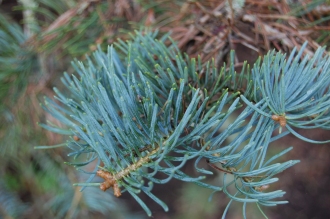Position: Full sun to light shade
Flowering period: Spring
Soil: Moist, well drained
Eventual Height: 40m
Eventual Spread: 10m
Hardiness: 3a, 3b, 4a, 4b, 5a, 5b, 6a, 6b, 7a, 7b, 8a, 8b
Family: Pinaceae
Abies concolor is an evergreen coniferous tree with a narrowly conical habit. Its blue/ green leaves are needle like, flattened with a bluntly pointed tip, up to 6cm long and 3mm broad. Its trunk may achieve a diameter of up to 90cm. Its grey/ light brown bark is smooth, becoming scaly and fissured with age. Its male flowers are pale yellow pollen cones. Its fruit are upright cones, up to 12cm long and 4cm broad, purple when young, maturing to pale brown.
Abies concolor, commonly known as White Fir or Concolor Fir, is native to west North America. In its native habitat it grows in mountainous environments in mixed woodland at an altitude between 900m – 1,900m.
The etymological root of the binomial name Abies is derived from the ancient Latin name for the Fir tree. Concolor is from the Latin meaning ‘of the same colour’.
The landscape architect may find Abies concolor useful as an attractive evergreen tree for parkland or large gardens.
Ecologically, Abies concolor seeds are attractive to some birds.
The Royal Horticultural Society has given a number of varieties of Abies concolor their prestigious Award of Garden Merit.
Abies concolor prefers moist, fertile, well-drained soils. It will tolerate most pH of soil.
Abies concolor requires little maintenance.







Leave a comment